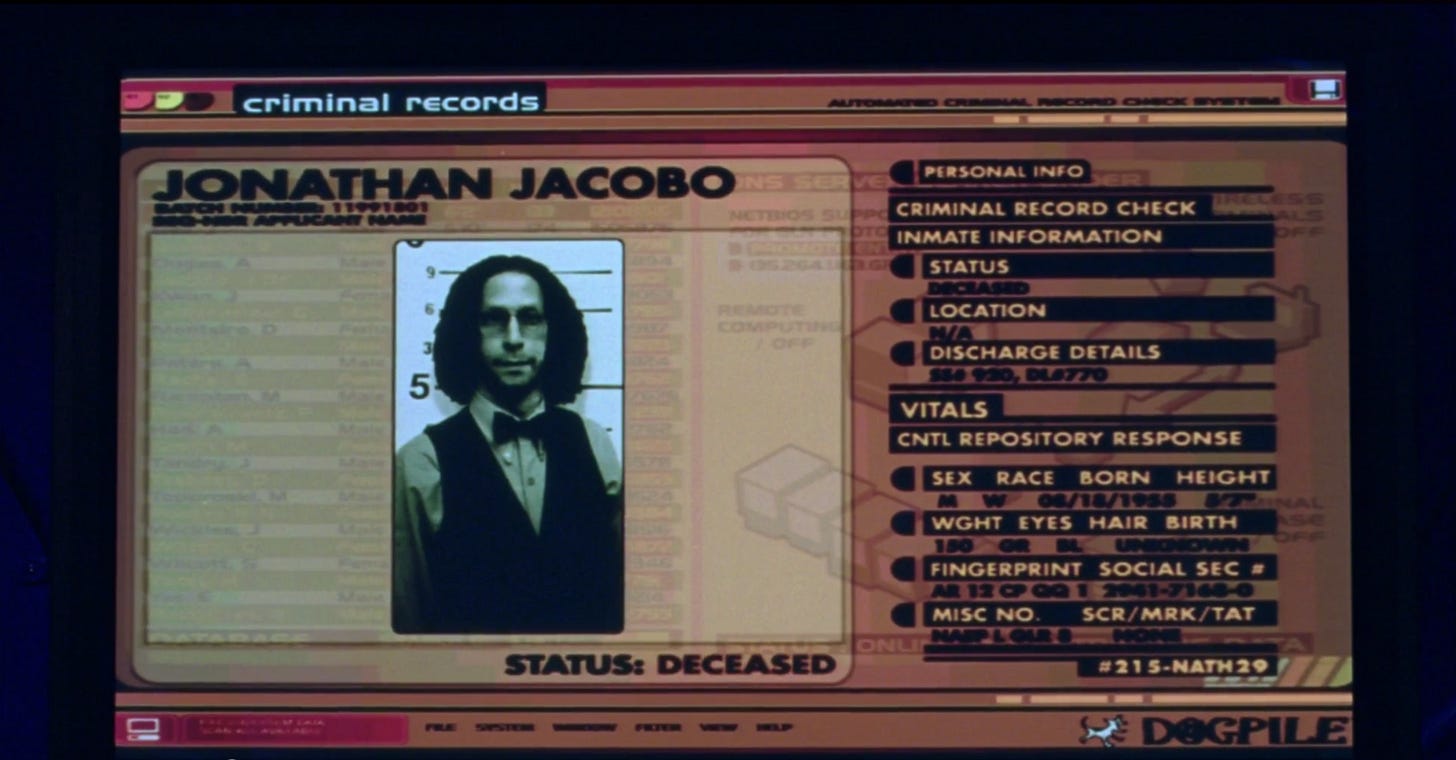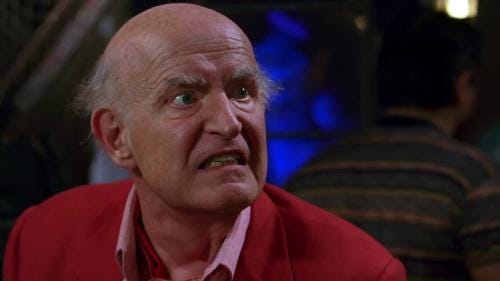Volume 1, Issue 23: Scooby Cinephilia
On the links between Scooby Doo 2: Monsters Unleashed, Young Frankenstein, and my childhood
Greetings! In my last newsletter, I told the story of my relationship with Rio Bravo as a preface to my new project, “Rio Bravo Diary.” You can read that newsletter here. I am currently on day 13 of my journey of watching Rio Bravo over the course of a year. You can see my most recent diary entry below.


As I wrote in that newsletter, and as I have mentioned before both in other issues of “Notes on Videographic Criticism” and on episodes of The Video Essay Podcast, I did not develop a serious interest in cinema until I was in college. And as much as I hate the tendency of some cinephiles to cast shame on people have not yet watched a film — “You haven’t seen that?!?” — I do often feel jealous of those who grew up obsessed with the movies.
One of the most rewarding aspects of having now hosted The Video Essay Podcast for more than a year is that I am able to look for patterns; for origin stories that overlap with one another and show the early makings of the audiovisual essayist. If there is ever a psychoanalytic study of the AV essayist, I am proud that my podcast will most surely be cited as a source! For example, many guests have cited the supercuts from the Academy Awards as an early influence; as the catalyst for their own desire to play around with their favorite films in an editing software.
Many guests have also described their obsession with recording films and TV shows on VHS tapes so they could not only watch again and again, but also so they could pause the film and examine the still images in greater detail. During our conversation, Johannes Binotto discussed how he used to photograph his favorite films. He later shared some of the photographs on Twitter:


And during my recent conversation with Nelson Carvajal (the episode will be released sometime in the next week or so; find your homework here), he talked about going to CVS as a child to buy blank VHS tapes and then meticulously counting out how many films he could preserve on a single tape.
Now, I know what you’re thinking: does Will even know what a VHS tape is? The answer is yes! I believe I am a member of the final generation who remembers not only using VHS tapes, but also borrowing them from Blockbuster and having to rewind the tape before it could be returned. I remember once on the way back to Blockbuster I realized that I had forgotten to do so and thought that I might be banned from ever borrowing again or, even worse, that I had destroyed the tape forever! I could be wrong, but I think it was a copy of Scooby-Doo Meets Batman. When I was a child (and even now), I was obsessed with Scooby-Doo and all of its forms. I would watch Cartoon Network on the weekend and hope and pray that an episode of the original Scooby Doo: Where Are You! would appear. (Side note: does anyone know why the official show title has an exclamation point and not a question mark?)
Speaking of questions, where am I going with all of this?
It is often the case that the interviews conducted for The Video Essay Podcast trigger memories of my own adventures in moviegoing. More specifically, not long after my conversation with Johannes, I remembered my fascination with the live-action Scooby Doo 2: Monsters Unleashed (2004), a classic if there ever was one.
For those unfamiliar with the film (it has been years since I last watched, so I’m relying here on the Wikipedia entry), the premise is essentially this: the villain, who, of course, the gang does not unmask until the end of the film, steals the costumes of monsters from past cases and turns them into real monsters. What makes the film so fun for fans is that many of the characters from Scooby Doo: Where Are You! make cameos, such as one of my personal favorites, the Ghost of Captain Cutler, who is from the original show’s third episode, “A Clue For Scooby-Doo.”
Like I’m sure most of the people reading this (no offense), I was — and still am— nerdy; obsessed with books, magazines, and the accumulation of information. I loved printing articles, images, Wikipedia pages — anything I could put into a folder and read over and over again. One of the things I loved most about Monsters Unleashed was that it required a sense of Scooby-Doo history.
Early in the film, when the gang first decides to solve the mystery, they pull up their online database of past cases and wonder who the criminal may be. As they discuss, digital files begin to appear on their jumbo computer screen:
It was during the podcast that these images came rushing back into my mind. I remembered that while watching Monsters Unleashed I would often pause the DVD so that I could try and read the information in the files. The resolution of the image, whether because of my DVD and/or the TV we had at the time, was too low for me to actually read them. But I tried anyway. I remember writing down what I could see in a notebook and wondering whether I could send a letter to whoever created the film (I did not yet know words like “studio” and “director”) and ask if they could perhaps print out the images and send them to me. I wanted to hold them; to study them; to feel as though I was a member of the gang and a part of their world. Of course, now that I actually see the images in high resolution (thank you, HBO Max), I realize that there is not much interesting information there to begin with! But, again, the content of the files aside, my true aim was to feel a connection with the cinematic world of Monsters Unleashed through a familiar object: information printed on a piece of paper!
*Spoiler Alert*
Looking at these images now, I do notice a few things. First, their database is called “DOGPILE.” Hilarious. Second, that the two men above remind me of another, more famous, duo:
I remember the first time I watched Young Frankenstein and saw Peter Boyle, I thought to myself, “He’s the villain from Scooby Doo 2: Monsters Unleashed!” And the same thing when I first watched Everybody Loves Raymond. For me, Mr. Boyle is always, first and foremost, Jeremiah Wickles.
But another similarity emerges.
Jonathan Jacobo (Tim Blake Nelson) is himself a kind of young Dr. Frankenstein; a scientist who was imprisoned for stealing money to finance his creation of monsters. As you may have guessed, it is revealed at the end of the film that Jacobo is the one who brought the monster costumes to life. But before they put the pieces of the puzzle together (you’ll see from the image above that Jacobo is supposedly deceased), the gang suspects Wickles, who was Jacobo’s cell mate in prison. Wickles was imprisoned for pretending to be the ghost of the Black Knight, the villain unmasked in the first episode of Scooby Doo: Where are You!, “What a Night for a Knight.” The gang suspects Wickles because one of the first costumes Jacobo brings to life is the Black Knight. Once again, a mad scientist resurrects Peter Boyle!
Podcasting, then, is not only a forum for conversation, but also for research and, perhaps most importantly, reflection. Listeners of The Video Essay Podcast are incredibly generous people, who often write to me with their own thoughts and reflections after listening to an episode. Now that the podcast has been around for more than a year, I’ve realized that I need to reflect more on not only the podcast’s impact on listeners and the wider video essay community, but also it’s impact on me. This post is my way of doing that. And as far as research goes, when I began writing this short essay I had not yet realized the connection between Scooby Doo 2: Monsters Unleashed and Young Frankenstein. Perhaps some day I’ll get around to making a mash-up of the two!
P.S.
On an unrelated note, a few weeks ago, as a preface to “Rio Bravo Diary,” I shared my videographic exeriment, “Rio Bravo, Bravo Rio.” Here’s another, “Rio Bravo in 15 Seconds”:
I was inspired by the trailer to The Muse (1999), directed by the great Albert Brooks. A big thank you to Alexander Greenhough for sending me the trailer!
Preview: Episode 20. Nelson Carvajal
In the coming week or so, I will released another episode of The Video Essay Podcast! Nelson Carvajal is a two-time Webby award nominated video artist and television producer. He is also the founder of the website Free Cinema Now. We discuss his video essay/mashup, "If Pride Rock Could Talk" and a supercut by Nicolas Longinotti, "Martin Scorsese: Hands."
News & Notes
I need your help curating this section!! Have something that should be featured? Email me: willdigravio@gmail.com
The Cary Comes Home Festival will be held from November 20-22! Read the full program here. And don’t forget to check out the wonderful group of video essays we received as part of “The Journeys of Cary Grant: An Audiovisual Celebration,” the partnership between the festival and The Video Essay Podcast. Festival Director Charlotte Crofts and I will be interviewing some of the creators for the festival. I will share the link to our conversation when it is available. In the meantime, watch the videos here.
“crisis, reality, ordinary”, a program of four films, including Re-Enacting The Future by Chloé Galibert-Laîné' and Kevin B. Lee. Curated by Taylor Mitchell.
For fellow podcast fans: a new article from Dario Llinares in Film-Philosophy, “A Cinema for the Ears: Imagining the Audio-Cinematic through Podcasting.”
A new open access book from Amsterdam University Press: Post-cinema: Cinema in the Post-art Era (h/t Catherine Grant).
And a final note from the British Association of Film, Television and Screen Studies!
 @thevideoessay @filmstudiesff @audiovisualcy @inTransitionCMS @tecmerinrevista @filmscalpel @NECSUS_ejms Please post the BAFTSS Annual Conference details - submissions of videographic film welcome! baftss.org/conf-2020 Theme "Time and the Body". Deadline: 1 Dec. Conference 7-9 April.
@thevideoessay @filmstudiesff @audiovisualcy @inTransitionCMS @tecmerinrevista @filmscalpel @NECSUS_ejms Please post the BAFTSS Annual Conference details - submissions of videographic film welcome! baftss.org/conf-2020 Theme "Time and the Body". Deadline: 1 Dec. Conference 7-9 April.ICYMI
The latest issue of MOVIE: A Journal of Film Criticism was released last week and features some wonderful video essays by Henry Rownd and Patrick Keating.
I was fortunate enough to attend a talk (pre-COVID times) by Patrick on his video essay, which centers on music in Harry Potter and the Prisoner of Azkaban. The event was held at the Birkbeck Institute of the Moving Image and hosted by Catherine Grant. Watch the event here.
From Oct. 23 - Nov. 26, Viennale and theAustrian Film Museum, in cooperation with sixpackfilm, will present “Recycled Cinema.” More here.
A fantastic new resource from Learning On Screen: “Introductory Guide to Video Essays.”
Student Spotlight: Recommendations Needed!
Each week, the newsletter will aim to feature a video essay made by a student along with a short Q&A. Is there a student or former student of yours you would like to see highlighted? Email willdigravio@gmail.com.
SUBSCRIBE TO THE PODCAST: iTunes | Spotify | SoundCloud









